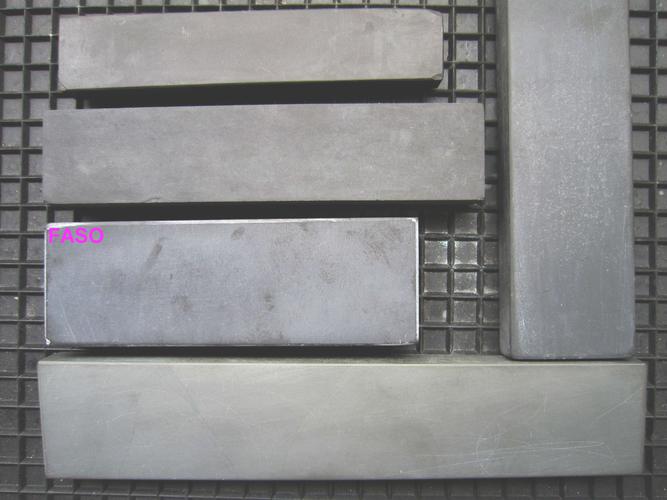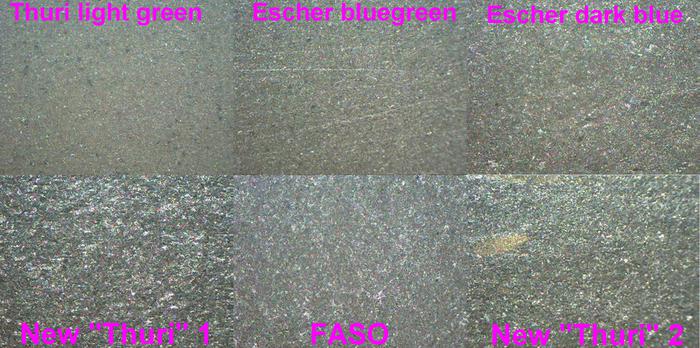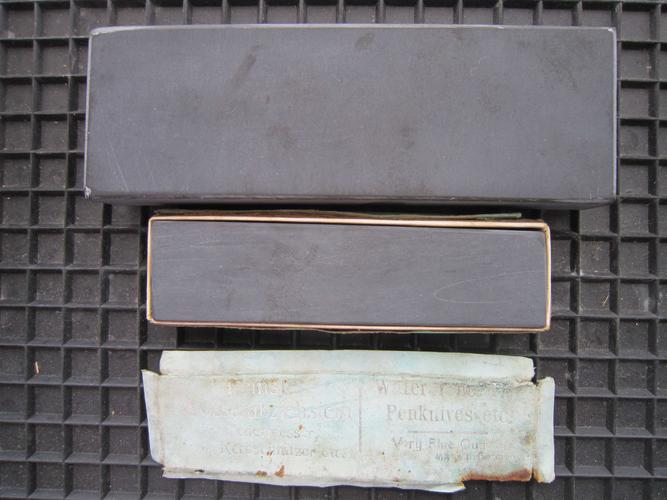Results 1 to 10 of 21
Thread: German FASO wtaer hone test
Threaded View
-
04-27-2014, 05:50 PM #1
 German FASO wtaer hone test
German FASO wtaer hone test
Sebastian (Doorsch) sent me this hone for testing.

It is quite an interesting hone. I have seen these Faso’s quite a lot in former years but less the last times. Reports on the type of stone and the performance of Faso labeled hones in different forums showing no uniform picture of this hones. Also there are hones with a quite comparable label from the view but calling “Faco’s” or different. Seems that this label has been changed or copied somehow in the past.
Aim of the test was to evaluate if this labeled Faso hone is of thuringian origin or type and if yes, one of the ancient mined one or a so-called new “thuringian”, means hones which are presently mined (but not in Thuringia) and sold by different companies.
First impression when I got the hone was very fine hone, scratches on my testing iron devices show scratches that also draw the conclusion of a fine hone. First thoughts were of a “normal” dark blue thuringian. When I compared the hone visually to my other dark blue ones it turns out that this hone is different. It is much more really blue than any of the blue thuringians I own. They all look dark grey or black compared to the Faso.

Did an endfinishing of a new honed razor, finishing was good, smooth feeling, hairtest no problem. Shave test was very good, sharp and smooth. Not as good as with a yellow-green thuri but quite comparable to the dark-grey or blue thuringians.
Then I took my best and most favorite razor of the last 2 years. It is a Rosemary razor, would say more than full hollow ground if this could be possible, but very thin grinded, simply perfect. The edge is really so fine that I feel any wrong honing stroke during shaving. Well this razor has nothing seen than a yellow-green thuringian as an endfinsher since I am shaving with it.
So I did about 20-40 strokes in total each side (following straight, circle and x-strokes) on the Faso. Hairtest after stropping no problem. Began shaving - sharp and smooth. Stopped after shaving half of my face.
Then I took the razor onto the new sold “Thuringians”, about 25 strokes each side. Hairtest very fair only after a lot of stropping. First movements in my face with the razor were awful. Not comparable to the Faso. Stopped shaving after some movements.
Went to my best yellow-green thuri. 30 strokes each side, stropping, shaving still awful. Another 50 more strokes on the yellow green thuri brought the razor back into a region, I like shaving with.
Conclusion: The Faso from Sebastian is a good endfisher that is comparable even with blue-green or blue thuringians according to my experience. It is of much better quality than the new “Thuringians”.
I suppose this is an ancient thuringian. Also the comparison under microscope shows, that the Faso is in the same league with the well known thuringians and Escher labeled hones.
Hones were all lapped to same degree, wet sandpaper 600 at last. The pictures were taken under microscope with magnification of 200, than copied together.

The white dots you can see is mainly quartz, the abrasive material. Clearly visible is the difference between total number of abrasive parts and upper size of the quartz particles in the different hones: light green less particles and smallest upper size of quartz, new "Thuris" much more and larger quartz particles. That’s what makes the difference in honing. Faso is comparable with dark blue Escher here.
Where does the name Faso come from? I still don’t know, can only speculate. Most thuringian hones were sold to the knife and razor companies in Solingen. They used the hones but also sold them under their own name or a fantasy name. So you may know Boker hones and there are a lot of other companies. “SO” in Faso may stand for Solingen, “FA” for fabrication or the company name? Only guessing! Someone may find the secret some day.
Finally found a hone in my collection that comes close in color and performance to the Faso. It is a small Penknife hone that also comes from the original thuringian mines.

Two final remarks:
Test is only to be seen for this one Faso hone. Other hones with same label might be different because of reasons I pointed out in the beginning.
I don’t want to disparage the so-called “new Thuringians”. I know where the hones are from and I know most of the sellers personally. The hones are quite good when set in the honing sequence at the right place. They are not endfishers in my opinion. This was just to show the difference to the Faso hone. For the price the new “Thuris” are sold, they have quite a good cost-performance ratio!
Regards hatzicho
-
The Following 9 Users Say Thank You to hatzicho For This Useful Post:
25609289 (04-27-2014), doorsch (04-28-2014), Hirlau (05-06-2015), Margeja (04-28-2014), Neil Miller (05-05-2014), RezDog (04-28-2014), Siguy (05-04-2014), Vasilis (04-28-2014), Walterbowens (04-28-2014)


 22Likes
22Likes LinkBack URL
LinkBack URL About LinkBacks
About LinkBacks






 Reply With Quote
Reply With Quote